Proper nutrition is the basis of a child’s health, which is laid down from early childhood. By 4-6 months, the need for additional energy, vitamins and minerals increases in the child. Food should provide the baby with all the useful substances that are necessary for the growth and formation of his body. The child’s first courses should consist of vegetables (mashed vegetables), dairy products for children and cereals. The first additional nutrition promotes the development of the masticatory apparatus, stimulates the enzymatic systems of the gastrointestinal tract and prepares the baby for weaning.
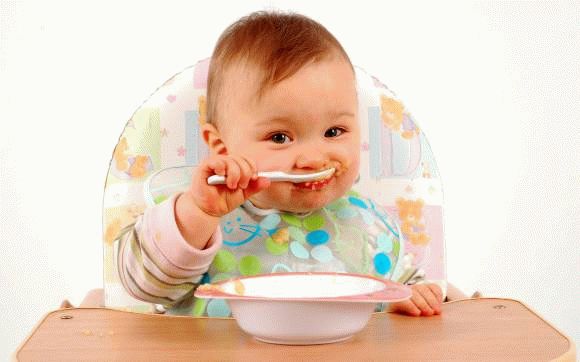
Beginning of feeding a child (since how many months)
Children on the GV
The best food for the baby in the first months of life is mother's milk. The feeding of a healthy baby who is breastfed should not begin earlier 6 months of age. By this age, mother's milk is no longer able to fully provide the baby with the necessary substances. The enhanced growth of its muscular, digestive, nervous, renal and protective systems requires additional nutrition. In detail about feeding a baby while breastfeeding
Children on IV
A child who has been using an artificial mixture since birth, by 4 months ready to receive new food. By this age, the baby's digestive system matures, intestinal immunity is formed and the increased permeability of its mucous membrane is normalized. Mechanisms are formed that are responsible for swallowing and digesting more solid foods. If you do not start feeding an artificer’s child at the age of 4 - 4.5 months, a deficiency of vitamins and minerals can develop in his body, and this will lead to the appearance of various pathologies. In detail about complementary feeding on artificial feeding
The readiness of children for the first feeding can be determined by focusing on their age and taking into account the following symptoms:
- the child more often than usual asks for mother's breast or a mixture in a bottle (does not overeat);
- the weight with which the baby was born doubled;
- the baby is able to sit with the support of an adult, while confidently holding the head and turning it in all directions;
- when solid food enters the child’s mouth, the reflex of its expulsion by the tongue is absent;
- the child has not been ill for several weeks, he has not been and will not be vaccinated in the near future;
- the baby is interested in the food of his parents, looking in plates and in the mouth of chewing.
We read in more detail about how to determine that a child is ready for feeding — 10 signs
Rules for the introduction of complementary foods
- Offer any new product to the baby, if only he is absolutely healthy.A contraindication to the introduction of new complementary foods is also the preparation for vaccinations, the period after them and the recovery from diseases of the gastrointestinal tract.
- Give complementary foods before breastfeeding (juices after feeding). We start with 5 g and gradually (over two weeks - a month) bring the amount of complementary foods to 150 g. All this time, carefully monitor the baby.
- When preparing juices and mashed potatoes at home, take the necessary measures: thoroughly wash your hands, kitchen utensils, fruits.
- Food for the infant should only be freshly prepared. Even short-term storage of the finished product in the refrigerator quickly leads to a deterioration in its quality.
- Feeding is given in a warm form, with a spoon, in the position of the child sitting. It is inappropriate to give 2 dense or 2 liquid foods of complementary foods in one feeding.
- It is not recommended to give the same type of food 2 times a day.
- Switch to another type of complementary foods only after the child gets used to the first - after 10-15 days.
- The basic rule of complementary foods is the gradual and consistent introduction of new products. A new type of complementary foods is introduced after full adaptation to the previous one.
- When administering complementary foods, keep an eye on your baby’s stool. If the stool remains normal, then the next day the amount of complementary foods can be increased.
- At each new stage of the introduction of complementary foods, be sure to consult your pediatrician.
Useful Tips for Moms
The video talks about how to balance a child’s diet and provide him with all the necessary nutrients.
Where to start the first lure
It used to be that the first product the baby was supposed to try this is juice (can be administered in 4-5 months). (By the way, we read on the topic:Teaching a child to drink from a mug) but this is not so.
Porridge and vegetables - these are actually the main products for entering the first feeding. If the child is underweight or unstable, it is best to start with cereals. Conversely, in case of excess weight, normal weight or a tendency to constipation, it is recommended to introduce complementary foods with vegetable puree.
Attention!
A few words about fruit puree and vegetable puree.
Fruit puree (usually a green apple and a pear) is such a traditional complementary foods that have been introduced to the baby for decades, one of the first, because it contains fiber, which has a good effect on the intestines, and children are happy to eat it. But some nutritionists and mothers notice that when they first try sweet fruits, the children do not want to eat mashed vegetables and cereals later.
Vegetable puree entering is quite difficult. It is not easy for a child to switch from the sweet taste of breast milk or a substitute to a completely unsweetened vegetable. You should be patient. It is necessary to offer a new dish more than once, but at least 10-12, and only after the child stubbornly refuses it, go to another type of vegetables.
Mistake. After the child has not taken this or that vegetable, parents usually go to cereal, making a big mistake! There is a high probability that the baby will not want to eat vegetables at all, after the introduction of sweet cereal. Moms make another mistake when they additionally sweeten cereals of industrial production.
- Vegetables (mashed vegetables). Ideal to start feeding: zucchini, broccoli, potatoes, cauliflower. It is important to first offer 1 type of vegetable and within 5-7 days to observe the reaction of the child. If during the period of adaptation there is no allergy or digestive upset, you can introduce a new type of vegetable, and then make a mixed puree. Salt in mashed potatoes does not need to be added until the child is accustomed to different tastes, he will like everything. (We read a detailed article on the rules of introducing vegetable foods + 3 popular vegetable puree recipe)
- Porridge.It is important to choose one-component, low-allergenic cereals that do not contain sugar, lactose, gluten (gluten-free cereals): they are buckwheat, corn, rice and oat. It is better if it is a product of industrial production, since porridge from the most chopped cereals, saturated with all the elements and vitamins necessary for the baby, is difficult to cook on its own. Don’t sweeten porridge! We repeat - to introduce porridge as the first feeding is recommended for children who do not gain weight. (We read about the first porridges)
- Milk products. If the baby does not suffer from intolerance to protein of cow's milk, at 6-7 months, cottage cheese can be introduced into his diet (About cottage cheese) It is better to cook it yourself by heating kefir in a water bath.
- See about cow's milk for newborns;
- See about goat milk for newborns.
- Meat puree. At 7 months, the baby is ready to eat mashed meat. It is best to offer canned mashed potatoes at the beginning of industrial production, starting with turkey, rabbit, beef or chicken (Details about meat purees and see the article - when to introduce meat into a child’s diet).
- Juices and fruits It is better to offer the baby later: at 7-8 months. The least allergenic are pear and green or yellow apple, then apricots, cherries, bananas, plums should be introduced. After 8 months, you can offer crumbs of kiwi and strawberries. If the baby eats cottage cheese, add the fruits that he tolerates into it - you get a finished afternoon snack.
- A fish. Only after 9 months of age should the child be given fish dishes. Such a complementary feeding should be introduced very carefully, since fish is a strong allergen. To start fish feeding, flounder, hake, pollock are suitable. At the same age, you can give your child kefir or bifidok for the night.
(Prepare an article with a clear menu of feeding the baby for months to a year. Soon a link will appear here)
(Table of the introduction of complementary foods. Clickable)
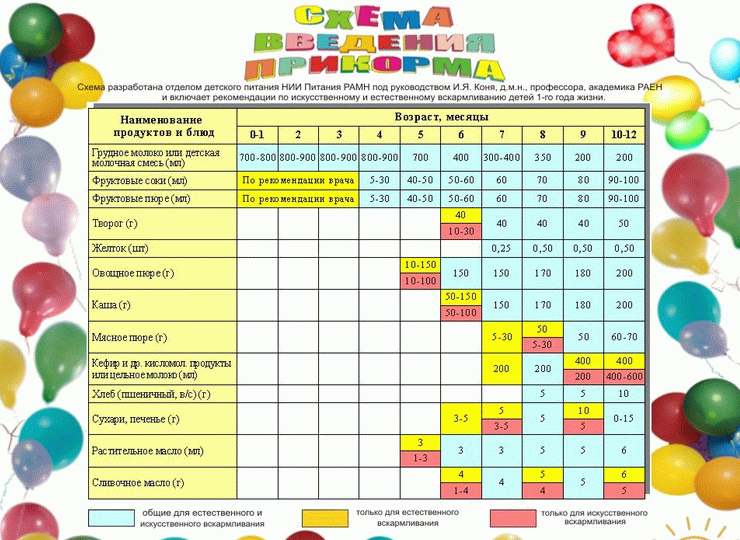
5 mistakes in the introduction of complementary foods
The correct introduction of complementary foods in the baby’s diet is the key to his good health. But often parents themselves provoke allergies and other problems, wanting to feed the baby something useful.
On the topic of complementary foods:
What to do, if baby refuses to eat complementary foods (does not eat from a spoon and does not want to eat porridge)
- Introducing soups (on meat broth)
- We select and buy the first necessary utensils -https://kid.htgetrid.com/en/veshhi-dlya-malyisha/pervaya-posuda-dlya-rebenka.html
Anna Gapchenko advises and answers questions: at what age and where to start complementary foods, how much to introduce new products

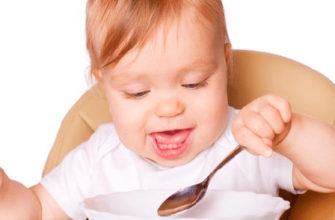

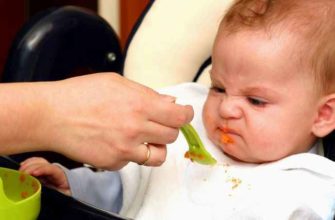

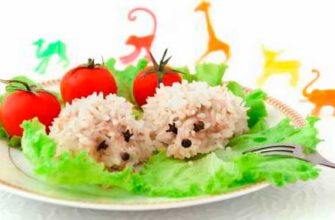



Yes, everything is really interesting and useful !!! Just why you can not start with fruit purees? We are 5 months old and I started with pumpkin and prunes since we have problems with the chair, it seems that the chair is starting to improve))
The first lure is a very individual matter. I just started to feed my children with fruit puree. The main thing is to know the measure and choose less allergenic fruits. The most optimal option for all tested apples or in combination with a pear. If you follow the strict rules of complementary feeding personally for your baby, then I think it will bring you only joy and benefit the baby.
You can’t use fruit, because the baby will get used to the sweet taste, then he won’t eat vegetables. Personally, I started complementary foods with mashed vegetables (broccoli, cauliflower and zucchini) at 5.5 months. There were no problems. The juice was introduced at 7 months, then fruit puree, cottage cheese.The last thing she introduced was meat. My child eats everything with pleasure.
Unfortunately or joyfully, but in my time there were completely different feeding rules that we followed and the children grew up strong and healthy. Today, mothers began to be lazy and for the most part switched to ready-made mashed potatoes and canned jars, juice boxes, so the children have weak immunity and they suffer from allergies, dysbiosis and other diseases begin, which we had not heard about before ... before we started complementary foods egg yolk, which was bred with milk, then there was vegetable and fruit puree, and after that there were broths and cereals.
As a complementary meal, we really liked the “Minute” cornflakes. They are very small and such a tender porridge turned out. My daughter ate it with pleasure. But I did not like apple juice and mashed potatoes.
Stupid mistakes in the text, they would fix it)))
Everything is individual! We started with mashed squash, we made it ourselves! Friends from Israel advised Materna puree. Natural and very tasty! We found an online store in Moscow to buy from them. And the reviews about this food are very good!
I almost didn’t have an allergy from this article, the word allergen is directly zombified. 50 years ago they didn’t even think about it! This is all nonsense! We feed the child what was closer to the nutritional benefits of the parents and no troubles, everything perfectly digests and no allergens - fish from the river, zucchini from the dacha at 6 months, and if you think about this article, you can’t enter anything at all
We introduced complementary foods from 4 months, it was cereal and mashed potatoes of sheep and fruits! Nothing wrong with that!
Of course, each child is individual, but still the sooner they started complementary foods the better!)
The most crazy article. Better industrial, better industrial .. and what manufacturers did not immediately indicate ?? Fruits should be introduced by 7-8 months because of the fact that the child will refuse other products? If you give potatoes after an apple, then of course it will refuse.
I always listen to my pediatricians, but I also read all sorts of forums, articles, look at the experience of others. All pediatricians switched to the new rules for the introduction of the first feeding - for a child who is naturally fed, it is advisable to introduce the first feeding from 6 months. I did just that with my little son, but I remember my oldest daughter, I gave my first porridge at 4.5 months, as the pediatrician advised me then. It seems that she has no problems with the intestines, it was 6 years ago. But pediatricians certainly know better. What about you?
I always listen to my pediatricians, but I also read all sorts of forums, articles, look at the experience of others, and I realized that all pediatricians switched to the new rules for introducing the first feeding - it is advisable to introduce the first feeding from the age of 6 to 3 months for a child who is naturally fed . I did just that with my little son, but I remember my oldest daughter, I gave my first porridge at 4.5 months, as the pediatrician advised me then. It seems that she has no problems with the intestines, it was 6 years ago. But pediatricians certainly know better. What about you?
Hello, where to start complementary foods? Buckwheat does not eat porridge ((
Complementary foods began with vegetables, but when it came time, Heinz bought dairy-free buckwheat porridge, then they tried oat, corn, and rice. My daughter ate with pleasure, and most importantly, there were no skin rashes.